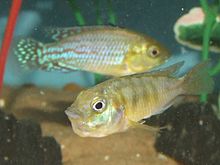Pseudocrenilabrus
| Pseudocrenilabrus | ||||||||||||
|---|---|---|---|---|---|---|---|---|---|---|---|---|

Pair of Pseudocrenilabrus nicholsi , the male on the left, the female on the right. |
||||||||||||
| Systematics | ||||||||||||
|
||||||||||||
| Scientific name | ||||||||||||
| Pseudocrenilabrus | ||||||||||||
| Fowler , 1934 |
Pseudocrenilabrus ( Gr .: "Pseudo" = false, fake + Crenilabrus (today no longer recognized wrasse genus )) is a genus of the cichlid family (Cichlidae), which in eastern Africa from the mouth of the Nile (Lake Mariout) over the White Nile , the Kyoga - and Albert , the Lake Victoria and its tributaries, the upper ( Lualaba ) and middle Congo and the Lake Upemba to and southern Africa (including the Zambezi . u Okavango ) is widespread.
features
Pseudocrenilabrus species are 7 to 11 cm long, females remain slightly smaller. Their body is of the typical perch shape, the head is large and brawny, the tail fin is rounded. The males are usually more colorful. All Pseudocrenilabrus species are mouthbrooders . In contrast to the closely related Haplochromis species, Pseudocrenilabrus has no egg spots on the anal fin. This, on the other hand, is colored intensely yellow to orange-red in most species at its edge and especially at its tip, which is interpreted as a color pattern similar to egg spots. The eggs are 1.5 to 1.8 mm in diameter and the fry leave the female's mouth after 12 to 14 days.
- Fin formula : dorsal XIII – XV / 8–11, anal III / 6–10
- Scale formula mLR 25–29
species
So far, four species have been described , two of which are divided into two or three subspecies due to their wide distribution and different colors.
-
Multi-colored mouthbrooder ( Pseudocrenilabrus multicolor ) (Schoeller, 1903)
- Pseudocrenilabrus multicolor multicolor (Schoeller, 1903)
- Pseudocrenilabrus multicolor victoriae Seegers, 1990
- Nichols mouthbrooders ( Pseudocrenilabrus nicholsi ) (Pellegrin, 1928)
-
Brass mouthbrooders ( Pseudocrenilabrus philander ) (Weber, 1897)
- Pseudocrenilabrus philander philander (Weber, 1897)
- Pseudocrenilabrus philander dispersus (Trewavas, 1936)
- Pseudocrenilabrus philander luebberti (Hilgendorf, 1902)
- Pseudocrenilabrus pyrrhocaudalis Katongo, Seehausen & Snoeks, 2017
Pseudocrenilabrus forms with the genera Lufubuchromis and Palaeoplex , as well as Thoracochromis moeruensis , Orthochromis kalungwishiensis , Orthochromis katumbii , Orthochromis luongoensis , Orthochromis machadoi and Orthochromis mporokoso a clade of closely related species within the tribe Haplochromini . This group of species can be detected by DNA comparisons , but has a common feature with a red or orange spot in the tip of the anal fin of adult males ( Pseudocrenilabrus spot). The Pseudocrenilabrus spot does not have a colored border and typical egg spots such as those of the Haplochromis species and the mouthbrooders of Lake Malawi are missing from the species of the Pseudocrenilabrus species group.
literature
- Hans Joachim Richter: Zwergbuntbarsche Neumann Verlag, Leipzig, Radebeul, ISBN 3-7402-0028-6 .
- Anton Lamboj : Pseudocrenilabrus. In: Claus Schaefer, Torsten Schröer (Hrsg.): The large lexicon of aquaristics. Eugen Ulmer, Stuttgart 2004, ISBN 3-8001-7497-9 , p. 819 f.
- Lothar Seegers (1990): Comments on the genus Pseudocrenilabrus Part 2: Pseudocrenilabrus multicolor victoriae nov. subsp. Aquariums and Terrarium Magazine , 43 (2): 99-103.
- Günther Sterba : The world's freshwater fish. 2nd Edition. Urania, Leipzig / Jena / Berlin 1990, ISBN 3-332-00109-4 .
Individual evidence
- ↑ a b Frederic DB Schedel, Viviane MS Kupriyanov, Cyprian Katongo & Ulrich Kurt Schliewen (2020): Palaeoplex gen. Nov. and Lufubuchromis gen. nov., two new monotypic cichlid genera (Teleostei: Cichlidae) from northern Zambia. Zootaxa, 4718 (2): 191-229. doi: 10.11646 / zootaxa.4718.2.3
- ↑ Matschiner, M., Musilová, Z., Barth, JMI, Starostová, Z., Salzburger, W., Steel, M. & Bouckaert, R. (2017): Bayesian Phylogenetic Estimation of Clade Ages Supports Trans-Atlantic Dispersal of Cichlid Fishes. Systematic Biology, 66 (1): 3-22. DOI: 10.1093 / sysbio / syw076 . Page 155 in the supplement .
- ↑ Frederic DB Schedel, Zuzana Musilova and Ulrich Kurt Schliewen (2019): East African cichlid lineages (Teleostei: Cichlidae) might be older than their ancient host lakes: new divergence estimates for the east African cichlid radiation. BMC Evolutionary Biology, 19:94. Doi: 10.1186 / s12862-019-1417-0
Web links
- Pseudocrenilabrus on Fishbase.org (English)

